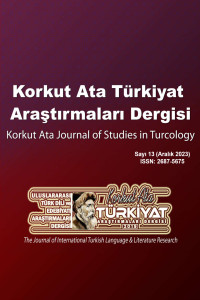Öz
Mehmed Es‛ad Ağa 18. yüzyılın sonları ile 19. yüzyılın başlarında yaşamış, önemli devlet görevlerinin yanı sıra dîvân tertip edecek kadar şiir kaleme almış bir şairdir. Hâne-i hâssa şairleri arasında değerlendirilen Enderunlu Mehmed Es‛ad Ağa’nın şiirlerindeki yer adları, sadece dîvân şiirinin metafor ve imgelerinden ibaret olmayıp şairin görevi ya da azledilmesi dolayısıyla bulunduğu yer ve mekân adlarını da içermektedir. 19. yüzyılda dîvân şiiri estetiğinin mahallîleşip soyuttan somuta doğru evrilmesiyle şiirde daha fazla yer bulan şehir ve mekân algısı, Es‛ad Dîvânı’nda da yerini almış, İstanbul’un semtleri, mekânları şairin gözlem istidadı ve tasvir yeteneğiyle de birleşerek şiirlerine çeşitlilik katmıştır. Aynı zamanda Es‛ad’ın şiirlerinde tespit edilen yer adları, özellikle şehirler dönemin sosyal, kültürel ve siyasal hayatı hakkında da izler barındıran tarihî birer vesika mahiyetindedir. Es‛ad, bulunduğu bu yerlerin tarihî dokusu, mimarisi, coğrafyası, tabiatı, kültürel farklılıkları gibi daha birçok ögesini şiirlerine yansıtmıştır. Erzurum gümrükçüsü olması hasebiyle şiirlerinde sıklıkla andığı Erzurum’un yanı sıra Mora, Yanya, Magosa, Gürcistan gibi birçok ülke, şehir, dağ gibi yer adlarından da faydalanan şair, bu coğrafyaların kendisine sunduğu bütün çağrışımlardan istifade etmiştir. Bu çalışmanın amacı Es‛ad Dîvânı’ndaki yer ve mekân adlarını tespit etmek ve tespit edilen bu adların dîvân şiirindeki kullanımıyla benzerlik ve farlılıklarını kaynaklar yardımıyla incelemektir. Bu noktada şairin coğrafya ve mekân algısını şiirlerine nasıl yansıttığı incelenirken üslup olarak yaşadığı çağın neresinde olduğu da tespit edilmiştir.
Anahtar Kelimeler
Kaynakça
- Devlet Arşivleri Başkanlığı Osmanlı Arşivleri, C.DRB. 46-2294, https://katalog.devletarsivleri.gov.tr, [Erişim tarihi: 03.05.2023].
- Eyice, S. (1992). Baruthâne. TDV İslâm Ansiklopedisi (C. 5, s. 94-96). İstanbul: TDV Yayınları.
- Kiel, M. (2013). Yanya. TDV İslâm Ansiklopedisi (C. 43, s. 317-321). İstanbul: TDV Yayınları.
- Onay, A. T. (2009). Açıklamalı Divan Şiiri Sözlüğü Eski Türk Edebiyatında Mazmunlar ve İzahı. İstanbul: H Yayınları.
- Özcan, T. (2020). Muhallefat. TDV İslâm Ansiklopedisi (C. 30, s. 405-406). Ankara: TDV Yayınları.
- Pala, İ. (2003). Lenterânî. TDV İslâm Ansiklopedisi (C. 27, s. 138). İstanbul: TDV Yayınları.
- Pala, İ. (2009). Ansiklopedik Dîvân Şiiri Sözlüğü. İstanbul: Kapı Yayınları.
- Pakalın, M. Z. (1993). Osmanlı Tarih Deyimleri ve Terimleri Sözlüğü I-II. İstanbul: MEB. Yayınları.
- Taşkın, F. (1994). Cağaloğlu. Dünden Bugüne İstanbul Ansiklopedisi (C. II, s. 370-371). İstanbul: Kültür Bakanlığı ve Tarih Vakfı Ortak Yayını.
- Tok Yıldız, H. (2023). Mehmed Es‛ad Ağa Dîvânı (İnceleme-Çeviri Yazılı Metin-Sözlük) Doktora Tezi. Samsun: Ondokuz Mayıs Üniversitesi.
- Toprak, S. V. (2019). Mehmed Şerif Paşa’nın Çıldır Valiliği. Belleten Dergisi, 83(296), 153-172.
- Yeniterzi, E. (2010). Klasik Türk Şiirinde Ülke ve Şehirlerin Meşhur Özellikleri. Uluslararası Sosyal Araştırmalar Dergisi-Klâsik Türk Edebiyatının Kaynakları Özel Sayısı-Prof. Dr. Turgut Karabey Armağanı, 3(15), 301-334.
Öz
Mehmed Es‛ad Aga is a poet who lived in the late 18th century and early 19th century and wrote poems amount to be able to organize a diwan besides his significant duties in the state. Place names appearing in the poems of Mehmed Es‛ad Aga of Enderun (Palace School), who is considered among the poets of Hane-i Hassa (Private Chamber), are not only composed of Diwan poetry metaphors and images but also names of the places where the poet was present due to his duty or dismissal. Urban and space perception finding a broader place in poetry with Diwan poetry aesthetics’ evolution from abstract to concrete upon its localization in the 19th century appeared in Es‛ad’s Diwan, too, and the districts and places of Istanbul offered a variety to Es‛ad’s poems by combining with his observation and portrayal skills. Furthermore, place names identified in the poems written by Es‛ad, particularly the cities, are also in the nature of historical documents bearing the traces of social, cultural, and political life of the period. Es‛ad reflected various elements of these places where he was present such as historical texture, architecture, geography, nature, and cultural differences in his poems. He made use of the names of many countries, cities, and mountains such as Morea, Janina, Famagusta, and Georgia as well as Erzurum, which he frequently mentioned in his poems as a consequence of being a customs officer in Erzurum and benefited from all the connotations offered himself by these regions. This study aims to identify the place names used in Es‛ad’s Diwan and analyze the similarities and differences between the identified names and their usages in Diwan poetry with the help of sources. In this regard, the poet’s way of reflecting the perception of geography and space in his poems was analyzed as well as determining his position in the era he lived in in terms of style.
Anahtar Kelimeler
Kaynakça
- Devlet Arşivleri Başkanlığı Osmanlı Arşivleri, C.DRB. 46-2294, https://katalog.devletarsivleri.gov.tr, [Erişim tarihi: 03.05.2023].
- Eyice, S. (1992). Baruthâne. TDV İslâm Ansiklopedisi (C. 5, s. 94-96). İstanbul: TDV Yayınları.
- Kiel, M. (2013). Yanya. TDV İslâm Ansiklopedisi (C. 43, s. 317-321). İstanbul: TDV Yayınları.
- Onay, A. T. (2009). Açıklamalı Divan Şiiri Sözlüğü Eski Türk Edebiyatında Mazmunlar ve İzahı. İstanbul: H Yayınları.
- Özcan, T. (2020). Muhallefat. TDV İslâm Ansiklopedisi (C. 30, s. 405-406). Ankara: TDV Yayınları.
- Pala, İ. (2003). Lenterânî. TDV İslâm Ansiklopedisi (C. 27, s. 138). İstanbul: TDV Yayınları.
- Pala, İ. (2009). Ansiklopedik Dîvân Şiiri Sözlüğü. İstanbul: Kapı Yayınları.
- Pakalın, M. Z. (1993). Osmanlı Tarih Deyimleri ve Terimleri Sözlüğü I-II. İstanbul: MEB. Yayınları.
- Taşkın, F. (1994). Cağaloğlu. Dünden Bugüne İstanbul Ansiklopedisi (C. II, s. 370-371). İstanbul: Kültür Bakanlığı ve Tarih Vakfı Ortak Yayını.
- Tok Yıldız, H. (2023). Mehmed Es‛ad Ağa Dîvânı (İnceleme-Çeviri Yazılı Metin-Sözlük) Doktora Tezi. Samsun: Ondokuz Mayıs Üniversitesi.
- Toprak, S. V. (2019). Mehmed Şerif Paşa’nın Çıldır Valiliği. Belleten Dergisi, 83(296), 153-172.
- Yeniterzi, E. (2010). Klasik Türk Şiirinde Ülke ve Şehirlerin Meşhur Özellikleri. Uluslararası Sosyal Araştırmalar Dergisi-Klâsik Türk Edebiyatının Kaynakları Özel Sayısı-Prof. Dr. Turgut Karabey Armağanı, 3(15), 301-334.
Ayrıntılar
| Birincil Dil | Türkçe |
|---|---|
| Konular | Osmanlı Sahası Klasik Türk Edebiyatı |
| Bölüm | Araştırma Makaleleri |
| Yazarlar | |
| Yayımlanma Tarihi | 31 Aralık 2023 |
| Gönderilme Tarihi | 9 Ekim 2023 |
| Yayımlandığı Sayı | Yıl 2023 Sayı: 13 |


